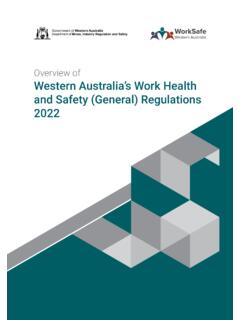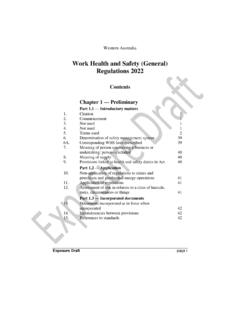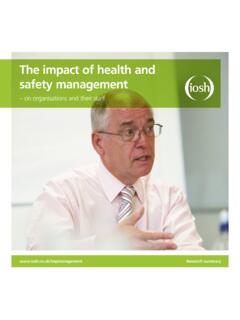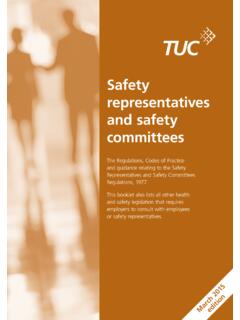Transcription of Workplace health, safety and welfare
1 The Workplace ( health , safety and welfare ) regulations 1992 cover a wide range of basic health , safety and welfare issues and apply to most workplaces (except those involving construction work on construction sites, those in or on a ship, or those below ground at a mine).The book includes the regulations in full, as well as the Approved Code of Practice and guidance. It will help employers understand the regulatory requirements on issues such as ventilation, temperature, lighting, cleanliness, room dimensions, workstations and seating, floor conditions, falls or falling objects, transparent and translucent doors, gates and walls, windows, skylights and ventilators, traffic routes, escalators, sanitary conveniences and washing revised and updated version takes account of changes to legislation since the previous edition was published, including: Quarries Miscellaneous health and safety Provisions regulations 1995; Quarries regulations 1999; Work at Height regulations 2005; Construction (Design and Management) regulations 2007; health and safety (Miscellaneous Repeals, Revocations and Amendments) regulations 2002.
2 Approved Code of Practice and guidanceL24 (Second edition) Published 2013 health and safety ExecutiveWorkplace health , safety and welfareWorkplace ( health , safety and welfare ) regulations 1992 HSE BooksHealth and safety ExecutiveWorkplace health , safety and welfarePage 2 of 60 Crown copyright 2013 First published 1992 Second edition 2013 ISBN 978 0 7176 6583 9 You may reuse this information (excluding logos) free of charge in any format or medium, under the terms of the Open Government Licence. To view the licence visit , write to the Information Policy Team, The National Archives, Kew, London TW9 4DU, or email images and illustrations may not be owned by the Crown so cannot be reproduced without permission of the copyright owner. Enquiries should be sent to Code of PracticeThis Code has been approved by the health and safety Executive, with the consent of the Secretary of State.
3 It gives practical advice on how to comply with the law. If you follow the advice you will be doing enough to comply with the law in respect of those specific matters on which the Code gives advice. You may use alternative methods to those set out in the Code in order to comply with the law. However, the Code has a special legal status. If you are prosecuted for breach of health and safety law, and it is proved that you did not follow the relevant provisions of the Code, you will need to show that you have complied with the law in some other way or a Court will find you at fault. GuidanceThis guidance is issued by the health and safety Executive. Following the guidance is not compulsory, unless specifically stated, and you are free to take other action. But if you do follow the guidance you will normally be doing enough to comply with the law.
4 health and safety inspectors seek to secure compliance with the law and may refer to this guidance. health and safety ExecutiveWorkplace health , safety and welfarePage 3 of 60 ContentsPreface 5 Introduction 7 About this book 7 Requirements under these regulations 7 Duties under these regulations 7 Risk assessment 7 Involving workers 8 About ACOPs 8 Presentation 8 Regulation 1 Citation and commencement 9 Regulation 2 Interpretation 9 Regulation 3 Application of these regulations 11 Means of transport 12 Extractive industries (mines, quarries etc) 12 Construction sites 12 Temporary work sites 13 Farming and forestry 13 Regulation 4 Requirements under these regulations 13 Modifications, extensions and conversions 15 Stability and solidity 15 Regulation 5 Maintenance of Workplace , and of equipment.
5 Devices and systems 16 Regulation 6 Ventilation 17 Regulation 7 Temperature in indoor workplaces 19 Thermal insulation 20 Solar radiation 21 Harmful or offensive fumes 21 Regulation 8 Lighting 21 Regulation 9 Cleanliness and waste materials 22 Regulation 10 Room dimensions and space 23 Regulation 11 Workstations and seating 24 Regulation 12 Condition of floors and traffic routes 25 Regulation 13 Falls or falling objects 27 Other regulations and standards 28 health and safety ExecutiveWorkplace health , safety and welfarePage 4 of 60 Regulation 14 Windows and transparent or translucent doors, gates and walls 29 Regulation 15 Windows, skylights and ventilators 30 Regulation 16 Ability to clean windows etc safely 31 Regulation 17 Organisation etc of traffic routes 31 Definition 32 General requirements for traffic routes 32 Separation of people and vehicles 33 Crossings 33 Loading bays 34 Signs 34 Regulation 18 Doors and gates 35 Regulation 19 Escalators and moving walkways 37 Regulation 20 Sanitary conveniences 37 Regulation 21 Washing facilities 37 Minimum numbers of facilities 39 Remote workplaces and temporary work sites 40 Ventilation.
6 Cleanliness and lighting 40 Other regulations and publications 40 Regulation 22 Drinking water 41 Regulation 23 Accommodation for clothing 41 Regulation 24 Facilities for changing clothing 42 Regulation 25 Facilities for rest and to eat meals 43 Facilities for pregnant women and nursing mothers 44 Preventing discomfort caused by tobacco smoke 44 People with disabilities 45 Regulation 26 Exemption certificate 45 Regulation 27 Repeals, saving and revocations 46 Schedule 1 Provisions applicable to factories which are not new workplaces, modifications, extensions or conversions 47 regulations 10 and 20 47 Schedule 2 Repeals and revocations 48 Appendix 1 Notice of Approval 52 Appendix 2 Extracts from relevant health and safety legislation 53 health and safety at Work etc Act 1974 Section 2 53 health and safety at Work etc Act 1974 Section 4 53 Factories Act 1961 Section 175(5) 54 References 55 Further reading 58 Further information 59 health and safety ExecutiveWorkplace health , safety and welfarePage 5 of 60 Preface This document contains the Workplace ( health , safety and welfare ) regulations 1992, together with an Approved Code of Practice (ACOP) and additional Workplace ( health , safety and welfare ) regulations 1992 (SI 1992/3004)
7 Implement most provisions of the European Commission Workplace Directive (89/654/EEC).Although failure to comply with any provision of the ACOP is not in itself an offence, the failure may be taken by a Court in criminal proceedings as proof that a person has contravened the regulation to which the provision relates. In such a case, however, it will be open to that person to satisfy the Court that he or she has complied with the regulation in some other and expressions which are defined in the health and safety at Work etc Act 1974 or in the Workplace ( health , safety and welfare ) regulations 1992 have the same meaning in the ACOP unless the context requires regulations and ACOP set requirements to ensure the Workplace does not adversely affect the health and safety of employees while they are in the Workplace .
8 Building regulations set standards to ensure that when a Workplace is built or altered it will meet the requirements of a safe and healthy Workplace . Building regulations that apply across England and Wales are set out in the Building Act 1984 while those that apply across Scotland are set out in the Building (Scotland) Act There are also Approved Documents2 supporting each of these Acts that offer further information and guidance. Standards will be the same, whether they apply to a building being constructed or to it being maintained. The standards set out in Building regulations should therefore be complied with in meeting the requirements of the Workplace regulations unless a higher standard is applicable for adequate protection of the health , safety and welfare of those in the Workplace so far as reasonably practicable.
9 Where there is an existing standard in Building regulations , it is referred to in this which does not form part of the ACOP is identified as such in this document. Where the guidance refers to another publication, its details are provided in the text or in the References section. health and safety ExecutiveWorkplace health , safety and welfarePage 6 of 60 health and safety ExecutiveWorkplace health , safety and welfarePage 7 of 60 Introduction About this book1 The Workplace ( health , safety and welfare ) regulations 1992 cover a wide range of basic health , safety and welfare issues and apply to most workplaces (with the exception of those involving construction work on construction sites, those in or on a ship, or those below ground at a mine see regulation 3).Requirements under these Regulations2 Employers have a duty under the health and safety at Work etc Act 19743 to ensure, so far as reasonably practicable, the health , safety and welfare of their employees at work.
10 People in control of non-domestic premises have a duty towards people who are not their employees but use their premises. The regulations expand on these duties and are intended to protect the health and safety of everyone in the Workplace , and ensure that adequate welfare facilities are provided for people at work. 3 Several of the regulations require things to be suitable . Regulation 2(3) makes it clear that things should be suitable for anyone. This includes people with disabilities. Where necessary, parts of the Workplace , particularly doors, passageways, stairs, showers, washbasins, toilets and workstations, should be made accessible for disabled under these Regulations4 People other than employers also have duties under these regulations if they have control, to any extent, of a Workplace .














